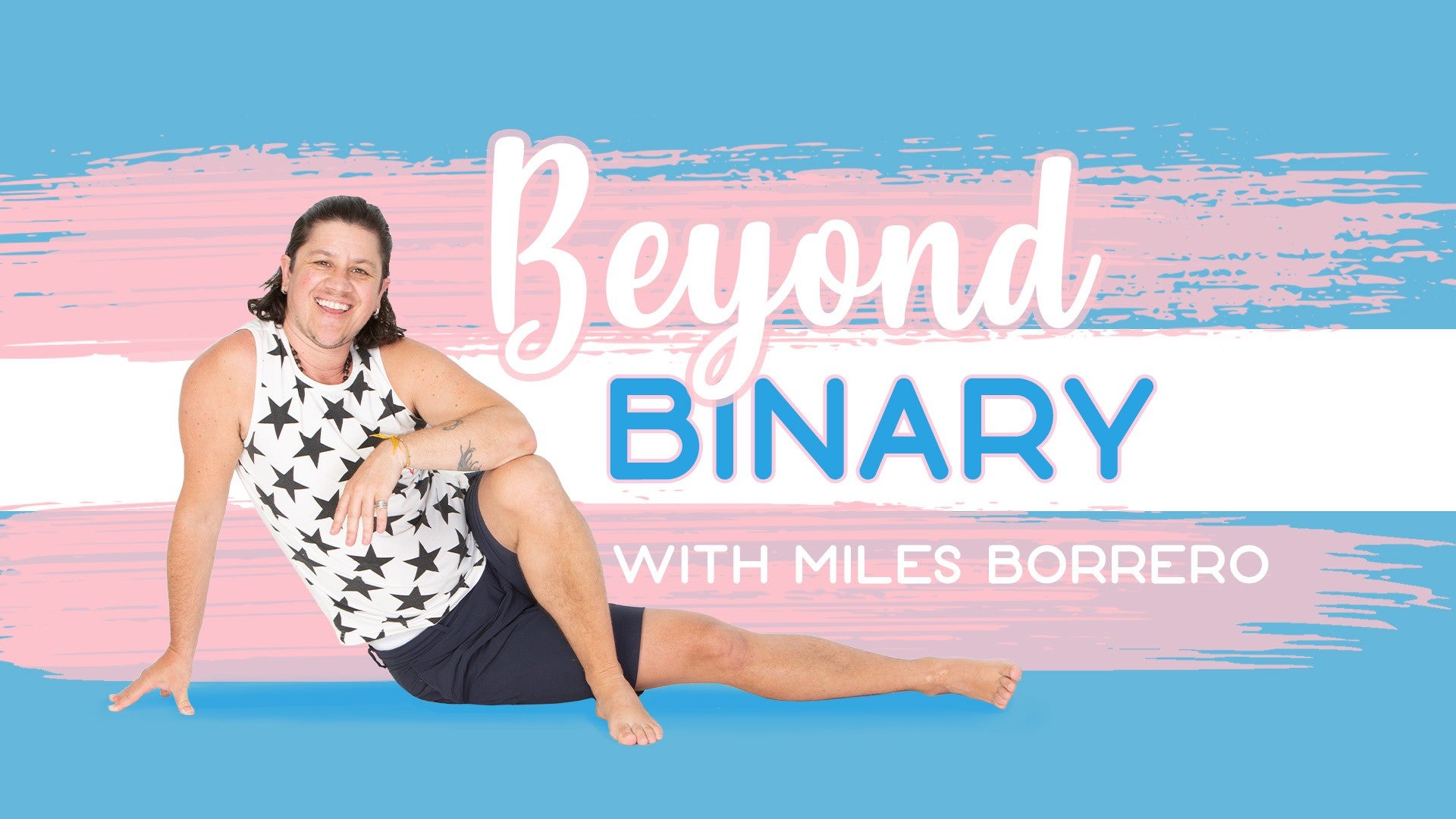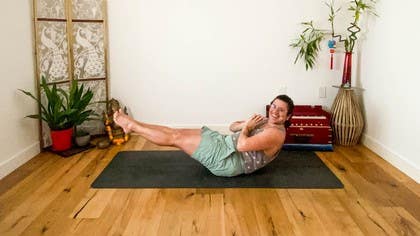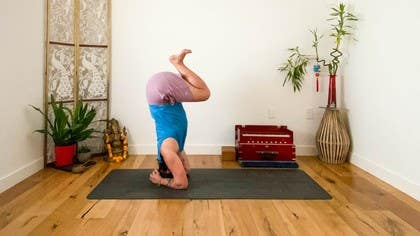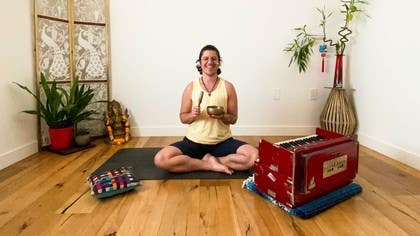Description
About This Video
Transcript
Read Full Transcript
Hi, team. Welcome to Yoga Anytime. I'm so thrilled to be with you. My name is Miles Barrero. You're here with Bowie. The last few episodes, we started with looking at form. Then we moved into space, the space inside the form. Then we started to look at the relationship between space and form, and now we're going to add another nuance to that, the nuance of balance. Many of us think of balance as this place that we arrive, like this island. In certain yoga poses, like a handstand, for example, we think that if we nail it once, that's it, and that's all we have to do. But balance is really like love. It's a relationship, not a landing strip. The idea is that every day we have to relate to our own sense of balance, which means sometimes we'll lean more towards being inside, for example, and having space, and sometimes we'll be more outside. We have to notice that or we have to learn to notice those things so that then we can balance out the pressure between the two and have lives that are a little bit more whole and not run ourselves as ragged, especially when we are in communities that are underprivileged and underserved. The question of balance becomes really huge because oftentimes we're tasked with having to teach and educate people about our situation, and that can be uplifting and it can also be really strenuous and challenging for us. So here we are exploring balance. You'll need two blocks for practice today. We're going to start sitting down, extend one leg out in front of you, and we're going to bring some attention to our feet. So start by touching the ball of your foot. You can choose whichever foot doesn't matter so much. And just massage the ball of the foot. And then we're going to do something that I really loathe, which is sliding your fingers through your toes, and it might feel horrible. I really don't like it. But it's so good for the toes. My toes like to think that they come always together. Start to move the ball of the foot.
But the reality is that you want your toes to be articulate. That's what helps you balance well on your feet. It might feel crunchy there or weird. Just breathe through it. And then bring your awareness to your arch and slide your fingers, your thumbs through your arch, massage the foot, open the sole of the foot, and then end at the heel and give the heel a little bit of attention, a little bit of love. And then release that, shake your toes out, make sure they're still attached. And we'll come to the other foot. So first just bringing some sensation to the ball of the foot, and then moving the ball of the foot around a little bit. And then the dreaded fingers through the toes. Oh, this one's even worse than the last one. And then start to circle and massage that. I'm one of those people that my toes can't even see those fingered toe socks. They run the other way. Breathe. If you're panicking like I am, just know that this too shall pass. And sometimes that just means that it gets a little, the edge softens a little bit around it. And then bring your back fingers to your arch, work the arch, work the ball of the foot, kind of opening and closing it. And then the heel. We're very used to standing on our feet. So we kind of take for granted how hard the feet work. And when we start to come into a sense of balance, especially on our hands, we want our hands to become as articulate as our feet. So we're also going to look at that today. And then from there, you'll take a nice tall seat. You can sit up on a block if you'd like. You can sit in a cross-legged seat. Sorry, boo-boo. Try not to disturb your four-legged. And settle into the breath. Close your eyes. You might still have a sense of openness in the soles of the feet. I definitely feel mine just ready. People sing together. The words are radhe govinda radhe. Radhe go pala radhe. Repeat after me. Radhe govinda radhe. Radhe go pala radhe. Singing is a way to connect the inner space to the outer space, the shape to the form. It's also a way to practice deep listening and also a very clear way to ensure that your needs are getting met in a deep way. So connecting to that essence of ourselves and allowing it to be in the room. You can join whenever you're ready. Radhe govinda radhe go pala radhe. Radhe go vinda radhe go pala radhe.
Radhe go vinda radhe go pala radhe radhe. Radhe go vinda radhe go pala radhe go pala radhe radhe. Palms together. Deep inhale. Waaaaaaaaaaaaaaaaaaaaaa And gently open your eyes. Stay in your seat for another moment. As you inhale, bring the arms out and up. Turn the palms to face forward.
And on the exhale, you're going to press your hands, the heels of the hands forward and your fingertips up as you bring the arms to shoulder level. So this is what it would look like in a plank pose. And then drag the arms down, bend your elbows, let the elbows bend right under the shoulders and flex your hands. Oftentimes when I do this, my students have their hands up or down. What I'm looking for is the wrist in line with the elbows.
So look down and make that happen. From there, as you inhale, widen your elbows out and round to the top of the spine. And then as you exhale, narrow the elbows in and do that almost to the extreme. Over narrow the elbows in and then look down and see how you're pinching your ribs with your elbows and how your fingertips are turning out. So that's going to be too much, especially when we're talking about the pushup, chaturanga.
So let the elbows release right underneath your elbows, right underneath your shoulders. And then from there, again, as you inhale, round and widen. And then as you exhale, only come to where the elbows are right underneath the shoulders. And let's do that one more time. The shoulder blades are about the size of the palms and they're imitating what the palms are imitating what the shoulder blades are doing on the back.
So this is going to be a really important position for hand balancing, arm balancing, and also for your pushup position. Release the hands, shake them out. Now we're going to come on to your back. From there, you're going to bring the big toes together and click your heels toward your bum. Reach your arms straight forward like you did a moment ago when you were seated.
And then from there, you're going to drag your elbows down by your ribs. Same situation, chaturanga. Now on the exhale, lift your head. The elbows will lift a little bit and then squeeze your knees around the upper arms. Imagine that you're in a crow pose against the ceiling.
You should feel your belly really working and your spine pushing into the floor. One more breath. Ooh, that's hard. And then hug your knees in. Super nice.
Now if it feels okay on your back, you're going to start to round back and round forward doing little swings. This is going to massage your vertebrae, which should feel pretty nice. If it doesn't, think of pushing your vertebrae back a little bit, but if your spine is very bony and your mat is very thin, you might need some extra padding. Now the next time you swing forward, we're going to come into navasana, bow pose. Hug your knees in, floint your feet, which means you're pointing your feet, but flaring the toes back.
You can keep the hands here at the backs of the knees, or you can reach the arms forward and lift your chest a little higher. Take two more breaths. One more. Now listen, as you exhale, the hands are going to come to the chest, the legs are going to reach forward, and then inhale, come back up, squeeze the knees toward the chest, exhale, lower halfway, arda navasana, come back up, lower halfway, come back up. Last one, lower halfway, stay, five, four, three, two, one.
Come back up, oh my goodness. Step the feet down, hips distance apart, hands under your shoulders, point your fingertips forward or if your wrists are punky, you can point your fingertips out to the sides, narrow your inner elbows, lift the chest, take an inhale, and on the exhale, lift your bum, shoulder blades slide back toward the knees, and your sternum, the center of the front of your chest slides back toward the skull, widen your abs. One more, and release down. We're going to do something a little trickier now, and you may or may not succeed, and it's okay either way. We're going to round back, round forward, do that a few times, gain a little bit of momentum, and then you're going to try to come up to stand.
It might mean that you need to cross your ankles, it might mean that you have to press your fingers into the floor, okay? You ready? Inhale, rock back, exhale forward, do that a couple of times, and then feet onto the floor, fold forward into a standing forward fold. Let your head dangle, release your arms. And super slowly around yourself all the way up, all the way up, all the way up to stand.
Stand in tadasana, mountain pose. Your feet can be together or separated hips distance apart. And that rigor of the form, the rupa, inhale, reach the arms out and up. On the exhale, fold forward over your legs. Inhale your right foot back, exhale your left foot back into plank pose.
Find those arms really reaching out of the shoulders. And then as you exhale, you're going to click your heels together and bend your knees and pull your bum back, the knees don't touch the floor. And then the tail chases the head as you round, round, round forward into your plank pose. Ooh, twice more, click the heels, bend, bend, bend, the knees don't touch the floor, I know it's hard, round, forward, plank pose. One more, click heels, bend knees, but not so much that they touch.
And then round, forward, plank pose. Lower the knees down. Walk your knees so they're underneath your hips. From there, the heels of your hands are right under the shoulders. Look at your fingers, point the fingers forward, pin the navel to the spine.
On the next inhale, lift the heel of the hand up, just the heel. So all the knuckles are down, the heel of the hand is lifted and exhale, lower down slowly. Both of them at the same time. Inhale, lift up, and exhale, lower, inhale, lift up, and exhale, lower, twice more, inhale, lift up, and exhale, lower, last one, inhale, lift up, and exhale, lower. Now pigeon toe your fingers, micro bend your elbows, wrap the elbows forward, we're going to take that, lifting the heel, inhale up, and exhale down, keep the inner elbows reaching forward, inhale up, and exhale down, inhale up, and exhale down, two more, inhale up, and exhale down, last one, inhale up, and exhale down.
Turn the hands out, bring the heels of the hands onto the mat, and the fingers kind of dropping off the mat, and then keep the arms long as you lean side to side, and then you can make it more organic and more fluid as if you were a leopard out looking for your next meal, and then maybe if you've been doing that on one side, try to reverse it, sometimes that can be a little bit of a mind twister or a koan. And then sit back onto your shins for a moment, bring your palms together, and appreciate the openness that you've built in your palms or that you've created for yourself. And then from there, hands will come right underneath the shoulders, walk your knees back just a little bit so that the knees are long, pin the navel to the spine. Now remember that exercise where we bent the elbows out to the sides? That's not what we're going to do.
We're going to bend the elbows straight back. So pull your chest forward, and on the exhale, bend the elbows a little bit or halfway down, straight back, inhale, press back up, and on the exhale, bend the elbows a little bit, straight back or halfway, press back up, one more time, bend the elbows, and press back up, tuck the toes under, press up and back, downward facing dog. I'm reminded of a meme that was going around where Britney Spears was saying that yoga is harder than it looks. Boy, she's on to something. Inhale the right leg high, on the exhale, step the foot right between the hands, inhale, lengthen your spine, step the left foot forward, and on the exhale, fold.
Soften your knees, round, all the way up, inhale, reach the arms out and up, exhale, fold forward over your legs, inhale the left foot back this time, exhale the right foot back into plank pose. Nice. We're going to do that thing where you click your heels, bend your knees, feel the weight of your body come back toward the heels of the hands, and then round, feel the weight come toward the fingertips. Click your heels, bend the knees, and then feel the weight come forward toward your fingertips. And one more, click your heels, feel the weight come forward toward your fingertips, lower your knees down, the knees will be long, don't walk them forward.
Take an inhale, exhale halfway down, elbows point straight back, inhale here, and lower everything down. Cup your fingertips out wide, elbows out wide, point your toes, inhale, snake up your spine, exhale ripple down. Inhale, snake up, exhale, ripple down. One more, inhale, snake up, and exhale, ripple down. Hands by the ribs, tuck your toes under, fire up your legs, lift the navel, take an inhale and you can come up either onto hands and knees or plank pose, all in one push.
And downward facing dog. Walk your feet to the middle of the mat, walk your hands to the middle of the mat, grab your trusty block, bring it to the lowest level right there, and the widest width. And then from there, you're going to come to stand on your block. Now try to stand on your block with the toes on the block and the heels dropping off of the block. And then from there, bend your knees and reach your arms up into Utkatasana, chair pose.
Feel all of that work in your legs. And then listen, don't drop your butt, keep your butt lifted, but start to lower your hands down toward the floor, slowly butt lifted. Don't drop your butt. And then from there, hands will come all the way to the floor, widen your knees. Now look forward about a foot in front of your fingers, bend your elbows straight back.
Maybe the knees come in contact with the elbows and then come high up onto your tiptoes, lean the weight forward, forward, forward. Maybe one set of toes points, click your heel up toward your bum. Maybe the other set of toes points, you're in your crow pose, and lower the feet down. Super nice. Take a moment, step off of your blocks, round yourself up to stand.
Our mind thinks when we come to hand balancing and balancing in general, that we're lifting up on the vertical plane, north, south, but really it's an exercise of tipping forward. So if you were to take your block out of the way, let's do this together. You're going to step from the heel of your right foot toward the toes to lift your left foot, and then step from the heel of your left foot toward the toes. When you feel how balance really happens on the horizontal plane, front, back. We're going to do the same thing as we walk back, toes to heel, and toes to heel, and toes to heel.
It's the same thing, your crow pose, your mind is going to tell you you're not strong enough because you have to lift your body weight up. But that's not at all what we're doing. What we're doing is we're tipping. The reason why we're keeping our butt up is because we're literally just tipping the weight forward from the heel of the hand toward the fingertips, which hopefully we've brought some sensitivity to that. So we're going to play with it one more time.
If you're done with the block, if you decide that you don't need the block, that's totally fine. We're going to do it with you on the block. Try not to rush the good parts, and by the good parts, I mean the really hard learning parts. You ready? Balls of the feet onto the block, bend your knees, lift your arms, lift your chest.
As you exhale, keep your bum lifted. Don't drop the bum. Keeping the bum lifted is going to enable you to just tip the weight forward when the time comes. As shoulder distance apart, bend your elbows, lean the knees forward toward the outer elbows or outer arms, and then come high up onto your tippy toes. Slowly, slowly, slowly come toward the fingertips.
I know it takes a little bit of risk. Look forward. That's going to tell your body to stop and click your heels up toward your bum and lower the feet, maybe as slowly as they came up. Step off of your block, separate your feet as wide as the mat. Hold onto opposite elbows.
Let yourself dangle, and then grab opposite, opposite elbows, dangle, dangle. Nice. Lower your knees down onto the floor. Feet together, knees wide. If your low back is rounding, and even if it isn't, lift your bum up, slide your booty back.
It's going to help deepen the creases of your hips, and then from there, fold forward. Take eight of your own breaths. Learning how to balance in the physical realm or learning how to negotiate balance is a better way of saying that. How to have a relationship to balance can really feed our relationship to balance on the daily. Inhale, lift up.
So really, what we're learning on our mats is like a lab for life. We learn that balance is a relationship on the physical realm. We come to our lives, and we fall, and we realize that it's no big deal. We can pick ourselves up, and really, the yoga is in the picking of the self up. Whenever you're ready, bring your knees together, point your toes, and lift your heels up.
Scoop the belly out as if you had an ice cream scoop. Frankenstein, your arms out in front of you, and then roll, roll, roll. The last few are the weirdest and hardest. Try to stay old, and release down, palms face up, extend your legs, and settle. Let the breath now come and go on its own, so you don't have to control it any longer.
Vabhanam, ukevalam, baba, babanam kevalam, baba, ukevalam, baba, babanam kevalam, babanam kevalam, babanam kevalam, babanam kevalam, babanam kevalam, babanam kevalam. Why don't we give a love? One more chance. Why don't we give a love? One more chance.
Why don't we give a love? One more chance. Why don't we give a love? One more chance. Love, love, love, love, love, love.
Keep in your breath, wiggle your fingers and your toes. Bend your knees, roll over onto one side. Take your time to come on up to sit. Close your eyes, settle into your body. Balance is a practice, just as much as love is.
We have to meet it and ourselves daily, and the reward can be great. Close to the heart, deep inhale. Love and light to all beings everywhere, no exceptions, namaste. Thanks yogis, see you next time.






You need to be a subscriber to post a comment.
Please Log In or Create an Account to start your free trial.